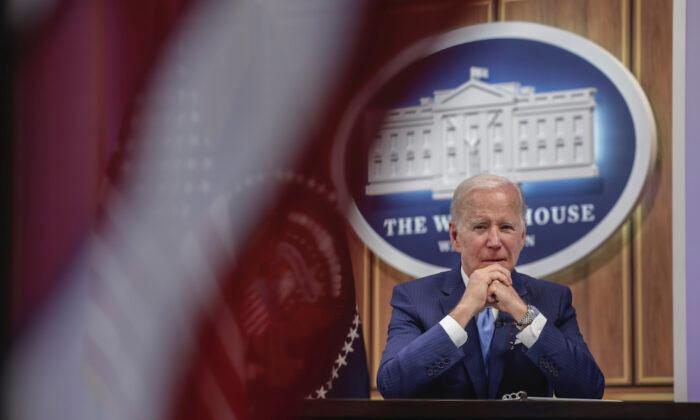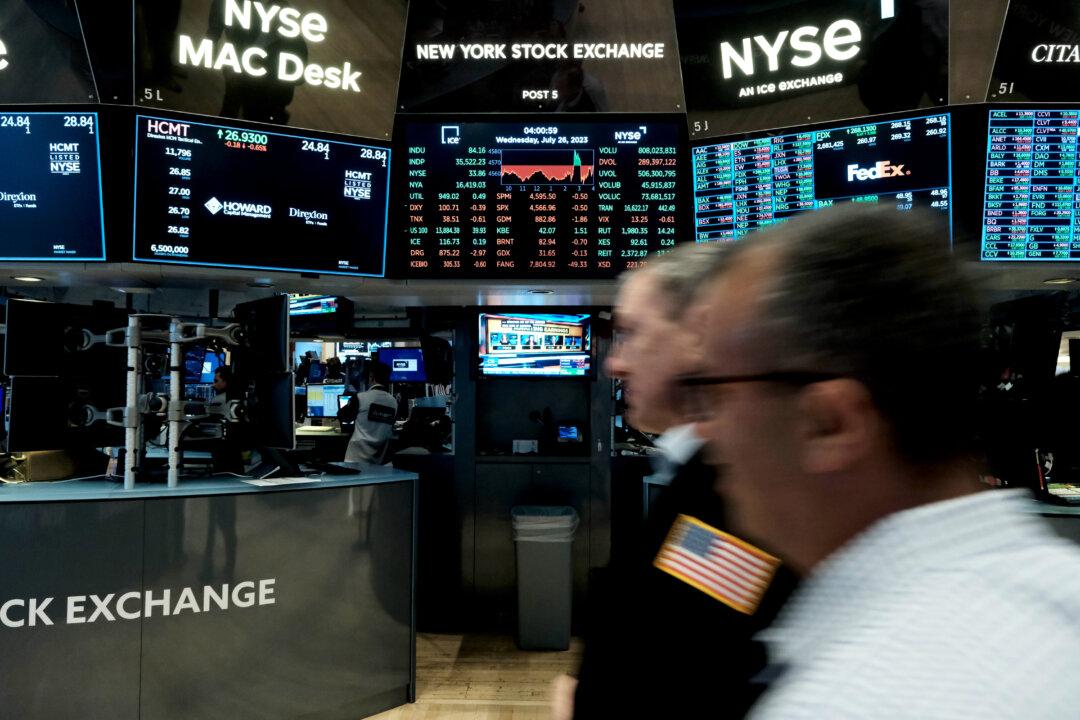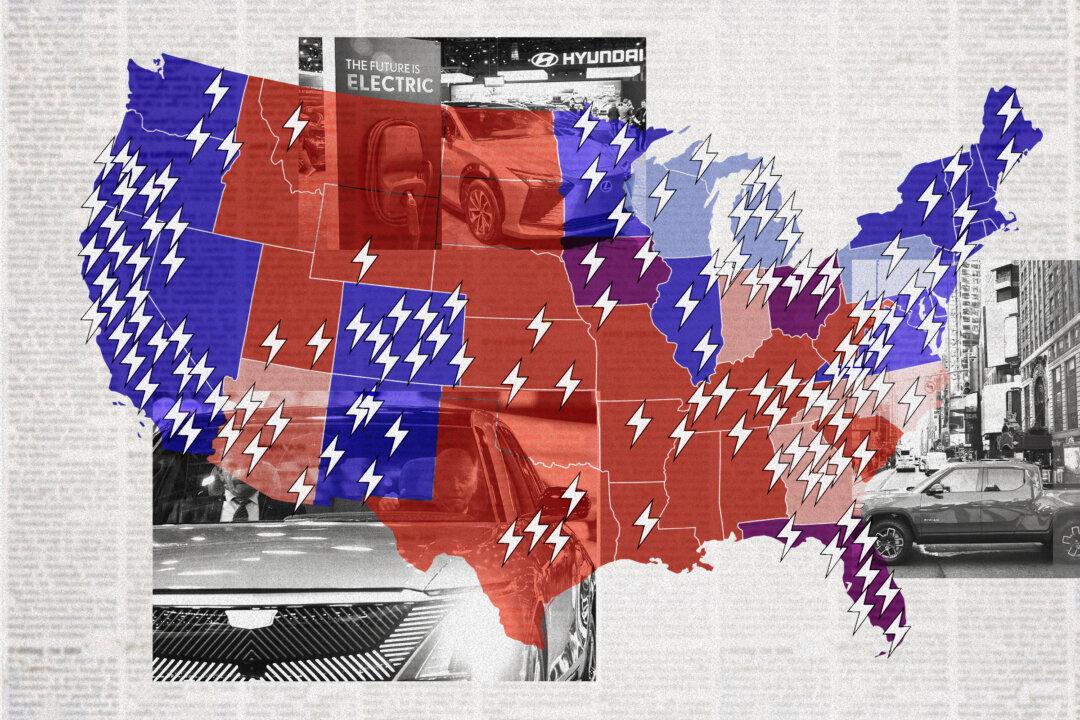This is a strange recession. Jobs remain plentiful even as the economy slows, pushing wages up even as record-high inflation and shortages reduce the standard of living for most Americans.
While many economists point out that the government has had a hand in most economic crises, government intervention in the U.S. economy over the past several years has extended far beyond anything we’ve experienced since World War II. These interventions include the forced closure of private businesses during COVID-19 pandemic lockdowns, $5 trillion in federal stimulus payments, an additional $5 trillion in new cash infusions from the Federal Reserve, use of the Defense Production Act to direct the U.S. energy industry toward wind and solar energy, and trade embargoes in response to Russia’s invasion of Ukraine that exacerbated already existing crises in fuel and food production.
The government continued its long march into private industry this year, as the Biden administration and Democrat lawmakers, with occasional Republican support, spent hundreds of billions of dollars to subsidize renewable energy, electric vehicles (EVs), and memory chip manufacturers through the Inflation Reduction Act, the CHIPs Act, and the Bipartisan Infrastructure Law.
“We’re seeing governments becoming even more intrusive in what used to be businesses run by business principles,” Ed Yardeni, president of Yardeni Research, told The Epoch Times. “Thomas Hobbes described the government as a Leviathan, just a monster that keeps growing. And that’s what governments are doing around the world.”
The Heritage Foundation’s 2022 Index of Economic Freedom downgraded the United States from a global ranking of 20th to 25th—the country’s lowest-ever ranking for economic freedom. As the U.S. government continues its expansion, federal debt has skyrocketed to 130 percent of gross domestic product (GDP), up from 100 percent pre-pandemic and 60 percent in 2001.
“The is absolutely unheralded in U.S. history, with the single exception of World War II, and after World War II, the debt was paid off rapidly, not by higher taxes but by growth,” economist Arthur Laffer told The Epoch Times. “We do not have a government spending triggered by war—we have a government spending triggered by transfer payments.”
The Inflation Tax and Declining Living Standards
While the official inflation rate today is 8.5 percent, a decline from 9.1 percent in June, it’s difficult to find items—whether they be groceries, cars, or appliances—that have increased by less than 10 percent over the past two years. This increase in costs far exceeds wage increases, which averaged 5.2 percent in August. And when the loss of savings is added in with the 18 percent year-to-date decline of the benchmark S&P 500 Index, most Americans today find themselves to be significantly poorer. Government stimulus checks and unemployment benefits have done little to fill the gap.Evidence of declining living standards can be seen in reduced household savings, increased household debt, and a spike in late payments. The Federal Reserve reported that, as of June 30, U.S. household debt hit a record $16.2 trillion, exceeding debt levels at the height of the mortgage bubble in 2008. The report states that “credit card balances saw their largest year-over-year percentage increase in more than 20 years.” A June survey by Forbes indicates that two-thirds of Americans are depleting their savings in order to pay expenses. A total of 20 million U.S. households, or 1 in 6, are now unable to pay their utility bills and have fallen behind to a total of $16 billion—double the pre-pandemic level.
The Fed has begun to take steps to tame the inflation it helped create, increasing short-term rates to 2.5 percent, but interest rates remain sharply negative, at 6 percent lower than the official inflation rate. The last time inflation hit double digits, during the Carter presidency, then-Fed Chairman Paul Volcker pushed rates up to 20 percent in order to tame it. At that time, however, the Reagan administration was working to boost supply while the Fed was working to cool demand.
“The last time the Federal Reserve raised interest rates dramatically to contain inflation, that coincided with a period of great deregulation of markets and was followed by the largest tax reduction in 100 years,” said economist Jeffrey Tucker, president of the Brownstone Institute and an Epoch Times contributor. “That inspired new growth, entrepreneurship, creativity, new energy, and optimism. None of that is taking place right now. Regulations are going up, litigation is increasing, taxes are growing, workers are demoralized. All of this is a prescription for inflationary stagnation.”
The Fed is sitting on a bloated $9 trillion balance sheet of bonds, which is effectively a price control on long-term interest rates. This, combined with negative short-term rates and supply shortages, has many economists concerned that high inflation has become a chronic feature of our economy.
Workers Dropping Out
In addition to inflating the dollar, government stimulus and unemployment payments have exacerbated a labor shortage. The ranks of the unemployed swelled during lockdowns, and many people never returned to the labor force, suggesting that the current unemployment rate of 3.7 percent could be misleading due to the millions of workers who have dropped out of the labor market altogether and are, therefore, not included in unemployment calculations. The labor participation rate, currently at 62.4 percent, measures the number of Americans working or seeking work as a percentage of the civilian population. It has recovered from lockdowns to an extent, but remains a full percentage point below pre-pandemic levels and has sunk to levels not seen since the 1970s, before women entered the workforce en masse.Taking population growth and employment growth into account, Laffer said, “we should have 6 million more people working than we do.”
“When you have a pandemic, you’d expect a lot of people dropping out from the labor force for a while and then coming back in,” he said, “but they haven’t come back in.”
Worker shortages add to the headwinds for the Fed’s efforts to fight inflation, meaning that the central bank will have to slam on the brakes that much more to dampen demand.
“Wages have been going up, of course, because there’s a shortage of workers,” Yardeni said. “There are 1.8 job openings for every unemployed worker. I’m not sure the Fed can bring wages down without causing a recession.”
Climate Policy Produces a Cold Winter
U.S. government intervention has been strongest in energy markets, and signs of America’s future, should we continue down this path, can be seen today in Europe. Having taken the lead in imposing green energy policies, Europe is now raising alarms about what the coming winter will bring in terms of fuel shortages and rationing.Bloomberg reporter Javier Blas attended weekly calls in which British energy traders quiz the managers of the UK’s national electricity grid; he said that “listening to them is getting scarier by the week.” Despite government assurances that the public has nothing to worry about, Blas reported urgent questions from traders regarding “emergency arrangements” in the coming months, what can be done if energy exporters such as France and Norway cut off exports to take care of their own citizens, how the UK will “secure power over the winter,” and how it will achieve “demand destruction” to cope with shortages.
Wholesale electricity prices surged by 1,000 percent in the UK, from 60 British pounds per megawatt hour in January 2021 to nearly 600 pounds currently. The forward market for electricity, a benchmark for future energy prices, indicates that prices will likely increase by another 50 percent by December.
Other European countries have begun warning their citizens to prepare for fuel shortages this winter, including France, Finland, and Germany, the latter of which banned fracking and shut down its nuclear plants as part of a series of green energy laws over the past 20 years known as the Energiewende. Germans are now resorting to burning coal and stockpiling wood for the winter to heat their homes. Shell Oil CEO Ben van Buerden has said that fuel shortages in Europe will likely continue for several more years.
The Biden administration has been less authoritative than European governments in imposing its energy policy on Americans, but only because it has been restrained by the need to get congressional approval and by recent U.S. Supreme Court decisions blocking administrative overreach, including Environmental Protection Agency mandates that electric utilities switch to renewable energy. Instead, the administration has relied on $100 billion in subsidies for renewables, executive orders, use of the Defense Production Act, and administrative actions against fossil fuel production. These include the denial of drilling permits, canceling the Keystone XL pipeline, and the Securities and Exchange Commission’s (SEC’s) new “green accounting” mandate, which forces listed companies to provide audited reports not only on their own carbon dioxide emissions, but also on those of their suppliers and customers, which brings smaller, privately owned businesses under the mandate as well.
“Politicians around the world have made it clear to the fossil fuel industry that they want to put them out of business, which is not a good way to run a transition from fossil fuels to clean energy,” Yardeni said. “It means the industry is not investing in keeping the supply of fossil fuels consistent with the demand until the transition can be accomplished.”
A hallmark of government industrial policy is investment for political rather than economic reasons and cumbersome mandates that are slow to change or adapt. The inevitable result is investment in outdated, inefficient, and inferior technologies, as well as a distortion of the equilibrium between supply and demand that free markets are best equipped to satisfy.
Despite regulatory support and hundreds of billions of dollars in subsidies, wind and solar energy have utterly failed to meet peoples’ need for reliable fuel and haven’t succeeded in reducing carbon emissions. Rather, these technologies have only succeeded in exporting emissions to China, Africa, and South America, where components of wind turbines, solar panels, and batteries are mined, refined, and manufactured.
“The free market would not fail to provide the resources that people want,” Michael Rectenwald, political author and former New York University professor, told The Epoch Times. “This is all about trying to change what people want and actually make unavailable what people need.”
Farming and Food Supply
The spike in energy prices has had a ripple effect through the entire global economy, from manufacturing to transportation, but U.S. farmers have been hit particularly hard by the high cost of fossil fuel derivatives, such as diesel and fertilizers.Fertilizer prices hit record levels in 2021, and while U.S. President Joe Biden has blamed this on Russia, most of the price increases occurred before Russia invaded Ukraine. In January, prior to the invasion, ammonia-based fertilizer prices had already escalated to almost $1,500 per ton, up from less than $600 per ton one year prior. The price increased slightly to $1,636 per ton after the invasion, before returning to pre-invasion levels of $1,469, as of July 15.
The cost of diesel fuel to run tractors and transport vehicles rose from $2.68 per gallon in January 2021 to a high of $5.75 per gallon in June, decreasing slightly to $5 per gallon in August. This doubling of input costs for farmers has pushed many to the brink; while those who can pass on costs to consumers may survive, those who can’t will likely go out of business. Many farmers, hoping the price hikes are temporary, coped by not fertilizing their fields, which reduces yields and depletes the soil of nutrients.
Americans see the results at the grocery store. According to the Bureau of Labor Statistics, as of July, the prices of bread, cereal, and dairy products are up by 15 percent from a year ago, meat is up by 11 percent, fruits and vegetables are up by 9 percent, beverages are up by nearly 14 percent, and “other food” items are up by nearly 16 percent.
Added to this is the SEC’s “green accounting” mandate, which requires all listed companies to report the emissions of their suppliers and customers. This will likely mean that even smaller family farmers will have to account for their emissions to comply with this mandate.
A report by Shelby Myers, an agricultural economist, states: “The onerous reporting requirements is not only an issue in regard to disclosing private data and having to find ways to comply with burdensome reporting, it could also disqualify small, family-owned farms from doing business with companies that procure the products grown on that farm. This could lead to more consolidation in agriculture.”
Climate-change policy for farmers has been more draconian outside the United States. At a time when the World Food Programme deemed 2022 as “the year of unprecedented hunger,” the Netherlands government announced a plan for a 30 percent reduction in livestock in order to achieve “an unavoidable transition” to emissions reduction. Intensive livestock farming there has produced ammonia and nitrous oxide, a greenhouse gas. Nitrogen fertilizers must also be cut.
In August, Canadian Prime Minister Justin Trudeau announced his plan to reduce fertilizer and farming emissions by 30 percent. And Sri Lanka, after banning chemical fertilizers in favor of organic farming in 2021, now faces severe food shortages, as crop yields plummeted.
When Industrial Policy Fails
One of the ironies of government policy is that when intervention inevitably causes a crisis, administrators declare that more intervention is necessary to fix it. On Aug. 29, French Prime Minister Élisabeth Borne told companies to draft energy savings plans in preparation for government rationing of gas and electricity. Germany is also making plans to ration energy, with bureaucrats gearing up to decide how much will go to keep industry operating and how much to heat homes.In June, Biden sent a letter to oil company executives accusing them of price gouging and profiteering “at a time of war.” In May, Democrats in Congress passed legislation that would allow Biden to declare an energy emergency and clamp down on oil companies that he believes are raising prices too high.
The extent of government control over our economy today means that how and when we emerge from this recession will depend on the whims of politicians and administrators.
“We have an inflationary world, with the Fed issuing all sorts of monetary liabilities,” Laffer said. “We have a low-output world, with a lot of money chasing few goods, with fewer workers, which leads to even higher prices. Now, what happens in the future depends on policies.”
Yardeni said, “The good news is that there is still a private sector with lots of entrepreneurs that have been able to succeed, notwithstanding the meddling of government.”
Ultimately, Rectenwald said: “This kind of interventionism and top-down system will fail. They’re going to gut the middle class; the middle class is being gutted as we speak. The question is, how long will it persist until it finally collapses?”






Friends Read Free